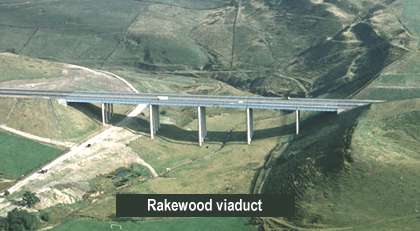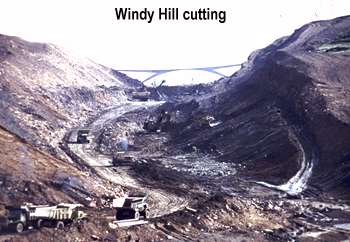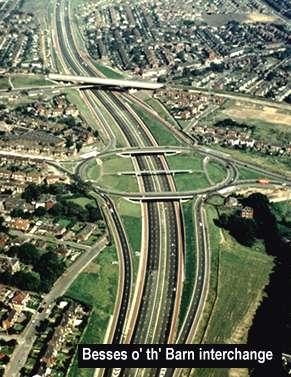The full archive for this scheme is stored at the Lancashire CC Record Office. Click to see details of this record office, then delete the popup page to return. There is not yet an Accession Number for this data.
| ITEM | DESCRIPTION | DATE | AUTHOR/ORIGINATOR |
| 1 | 'Engineer Appreciation' ( pages) |
1962 |
F R Oliver OBE |
| 2 | Route Location and Preliminary Design Personal Memories (9 pages) |
1998 |
A C Henry |
| 3 | Lowering and Dualling the East Lancashire Road A580 (2 pages) |
1970 |
D Barlow Resident Engineer |
| 4 | Lowering and Dualling the East Lancashire Road A580 (3 pages) |
1970 |
L Taggart R McGregor & Sons Ltd |
| 5 | Bridge Reconstruction at Besses o' th' Barn. (2 pages) |
January 1968 |
The Railway Gazette |
| 6 | Advance Works Road and Rail Bridges at Besses o' th' Barn (2 pages) |
1970 |
J F Davies Resident Engineer British Railways |
| 7 | Advance Works Road and Rail Bridges at Besses o' th' Barn (2 pages) |
1970 |
A B Hewitt Leonard Fairclough Ltd |
| 8 | Contracts M62/1 and 2 Bridgeworks and Preliminary Earthworks at Worsley and Swinton (7 pages) |
2000 |
A C Henry |
| 9 | Contracts M 62/1 and 2 Advance Bridgeworks etc Liverpool East Lancashire Road A 580 to the Irwell Valley (3 pages) |
1970 |
R Greatrix MBE |
| 10 | Contracts M 62/1 and 2 Advance Bridgeworks etc Liverpool East Lancashire Road A 580 to the Irwell Valley (3 pages) |
1998 |
R Greatrix MBE |
| 11 | Advance Bridgeworks Contracts M62/1, 2 and 5 |
1970 |
M S Padmore Costain Ltd |
| 12 | Contract M62/2 Worsley to Whitefield Section (2 pages) |
1970 |
G Cartwright A Monk & Co Ltd |
| 13 | Contract M 62/3 Rakewood Viaduct (3 pages) |
1970 |
A A Smales Resident Engineer |
| 14 | Contract M 62/3 Rakewood Viaduct (4 pages) |
1970 |
D A Stephenson Reed & Mallik Ltd |
| 15 | Contract M62/4 Advance contract Milnrow to Rakewood Viaduct |
1970 |
R J Clear Resident Engineer |
| 16 | Contract M62/4 Advance contract Milnrow to Rakewood Viaduct (2 pages) |
1970 |
G S Williams Sir Alfred McAlpine & Son Ltd |
| 17 | Contract M62/4 Advance contract Milnrow to Rakewood Viaduct (2 pages) |
1970 |
I G Trueman Leonard Fairclough Ltd |
| 18 | Contract M62/5 Advance bridgeworks Heywood to Rochdale (3 pages) |
1970 |
J H Thomas Resident Engineer |
| 19 | Contract M62/6 A580 to A56 (Basic information file) (7 pages) |
1968 |
Lancashire Sub-unit NWRCU |
| 20 | Contract M62/6 A580 to A56 ( 4 pages) |
1970 |
T E Gartside Resident Engineer |
| 21 | Contract M62/7 Whitefield to Yorkshire Boundary Basic information file (9 pages) |
1969 |
Lancashire Sub-unit NWRCU |
| 22 | Contract M62/7 Whitefield to Yorkshire Boundary (3 pages) |
1970 |
R J Clear Resident Engineer |
| 23 | Contract M62/7 Whitefield to Yorkshire Boundary (2 pages) |
1970 |
M C Jackson Sir Lindsay Parkinson & Co Ltd |
| 24 | Contract M62/8 Worsley Court House to A580 (3 pages) |
1970 |
C Andrews Resident Engineer |
| 25 | Contract M62/8 Worsley Court House to A580 (5 pages) |
1970 |
J Lindsay Smith Reed & Mallik Ltd |
| 26 | Linking the M62 and M61 Motorways in Lancashire (11 pages) |
April 1971 |
Roads and Road Construction |
| 27 | 'Motorway across the Pennines' The Lancashire-Yorkshire Motorway M62 and Scammonden Dam Inaugural Visit by HM the Queen (50 pages) |
14 October 1971 |
Department of the Environment Lancashire CC W Riding CC Huddersfield CBC |
| 28 | 'Motorways in Lancashire under construction -1969' (13 pages including photo, maps and diagrams) |
1970 |
Lancashire County Council Ministry of Transport |
| 29 | 'England's Mountain Motorway' (The Lancashire –Yorkshire Motorway M62) (11 pages including photos, maps and diagrams) |
1970 |
S Maynard Lovell CBE County Engineer & Surveyor West Riding of Yorkshire |
| 30 | Stability of Slopes on the Lancashire Pennine Section between Rakewood and Moss Moor Includes paper by E J Arrowsmith covering case histories of four rock slips in the construction of M61 and M62 (Large file with Appendices) |
October 1972 |
Chief Engineer Lancashire Sub-unit NWRCU |
| 32 | 'Commencing the Construction' (2 pages) |
1967 |
H L Yeadon |
| 33 | Widening - Junction 14 to 17. Environmental Statement. Non-Technical Summary, Public Consultation Leaflet. (6 pages) Draft Side Roads Order. |
Sept/Oct 1991 |
The Department of Transport |




